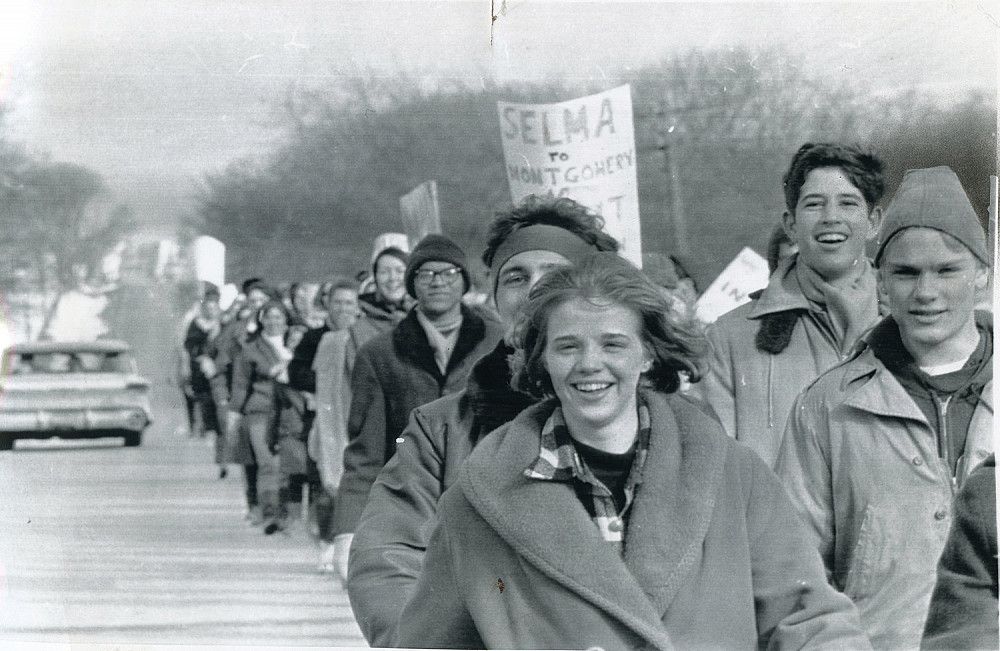Looking Back, Marching Forward: Sixty Years After Bloody Sunday
60 years ago, civil rights marchers attempted a peaceful march from Selma to Montgomery, Alabama and were attacked with nightsticks and tear gas. In response to this Bloody Sunday, Beloit College students made a two day trek to the Wisconsin state capital.

Credit: Beloit College Archives
On March 7, 1965, civil rights marchers attempted a peaceful march from Selma to Montgomery, Alabama, to protest voter discrimination and were met by state troopers and sheriff deputies who attacked them with nightsticks and tear gas. News coverage of the brutal violence on Bloody Sunday shocked Americans across the country. Selma was a catalyst for Beloit College students, and fifteen of them planned to travel to Selma in support of the marchers.
By March 9, they had raised nearly $600, enough to send eight people. Lots were drawn and within hours the students were on their way to Selma. Those left behind organized a 50-mile march from Beloit to Madison, approximately the same distance from Selma to Montgomery. Students created news releases for local radio stations which sent them buzzing over Associated Press wires.
Although the march was not sanctioned by the college, many professors cancelled classes and offered support. President Miller Upton stated that he was “pleased that students have chosen to demonstrate their belief in freedom in this positive manner.” He called Wisconsin Governor Warren P. Knowles and asked him to meet the students in Madison.

Credit: Beloit College Archives
Tuesday, March 9 was a cold, gray day and there was a gentle snow falling. After a briefing by Dean of the Chapel Anderson Clark and a meditation led by Professor of English Chad Walsh, around 175 students left campus accompanied by a police escort to Route 13 (Route 213 today). They walked two-by-two along the left side of the road. Along the way, faculty and other supporters served hot coffee, soup, and snacks, and provided encouragement as the students marched towards Evansville, their first destination. The marchers communicated from one end of the line to the other via walkie-talkie. A collie joined the procession near Orfordville, and the students nicknamed her “Selma.” The Beloit Daily News reported that the dog “constantly ran circles around the long line of marchers.” The marchers, carrying handmade signs reading, “We March in Freedom,” “Eight to Selma,” “To Madison in Appreciation,” and “Wisconsin a Free State in the United States,” received waves and cheers from some passing motorists, and heckling and abuse from others.
Back on campus, the Beloit College Young Republicans issued this statement: “We sincerely applaud and support the positive action taken by the students of our college in their march to Madison…Upon our record we stand as the party of civil rights trying to break the century-old tradition of racial segregation in the Democratic-dominated South. We support the struggle to give freedom and equality to all persons regardless of race and color.”
Another group, the Student Ad Hoc Committee for States’ Rights, criticized the march and wired Alabama Governor George Wallace to commend him for “the admirable manner in which you are upholding the laws of the sovereign state of Alabama.” According to the Round Table, the group collected money from about 30 people on campus and sent other telegrams to government officials. “Although the group did not disclose its size to the press, a spokesman told them that there were more than one would think.”
Darkness fell before the marchers reached Evansville. The Round Table reported that “the cold was piercing, and…long after dark, mud-splattered and weary, the survivors of the long trek hobbled up the steps of the church into a warm kitchen for dinner.” They stayed overnight at the Congregational Church, hosted by Reverend Alan Kromholz, who the previous May had participated in a voter registration drive in Canton, Mississippi. His study became an ad hoc first aid station for blistered feet and sore ankles. The Beloit Daily News described the church as “a litter of blankets, bedrolls, apple cores, first aid kits, socks, and boots…an inspiring [sight] to see the bedraggled but happy students crowded into the church sanctuary.”

Credit: Beloit College Archives
Wednesday morning, after breakfast at the First Methodist Church, the students resumed their march to Madison. They arrived in early afternoon, and Capital Times reporter Elliott Maraniss noted that “when the dome of the State Capitol came into view as they reached the top of a hill on Highway 14, a cheer swept the ranks of the boys and girls who had been walking in double file since noon Tuesday…The Capitol dome symbolized the purpose of the march: to demonstrate the freedom in Wisconsin as compared with Alabama, where marchers have been clubbed, whipped, and gassed.”
Beloit students and faculty marched to the Capitol where they were joined by 75 UW-Madison and Edgewood College students. After a short speech by Jim MacKenzie ’70, Professor Robert H. Irrmann spoke about an earlier generation of Beloit College students who had gone south during Reconstruction to help educate people freed from slavery after the Civil War.
Governor Knowles spoke to the marchers: “Tear gas and clubs used against defenseless men, women, and children may be effective temporarily in restraining such demonstrations, but the basic right of citizenship cannot long be denied by such means …Your presence here is evidence of your belief in America … I join you in the hope that freedom and justice will soon prevail in all the states of the union.”

Credit: Beloit College Archives
Lieutenant-Governor Patrick Lucey noted that in the 1964 Democratic presidential primary George Wallace had received 266,000 votes in Wisconsin. “We might look on this march as penance to help remove that mark on the state’s conscience,” he said.
However, Wisconsin’s only African-American legislator, Lloyd Barbee, D-Milwaukee, found himself rebuffed by the Wisconsin Assembly when he introduced a resolution condemning the violence in Selma. The Beloit Daily News reported that instead, the Assembly agreed to prepare a certificate of commendation for the Beloit College students, and that “later the Democratic controlled Rules Committee voted unanimously to offer a resolution denouncing the ‘shameful occurrences in Selma.’”
After a speech by Dean Andy Clark, the marchers walked to a nearby church for a reception with UW-Madison Chancellor Robben Fleming ’38 and his wife Sally Quixley Fleming ’39, Beloit College graduates and parents of one of the marchers, sophomore Nancy Fleming ’67. The weary students were driven back to Beloit in 18 cars and one bus, for rest, ongoing discussion, and further activism.
Condensed from “Fridays with Fred,” published online February 17, 2011.




